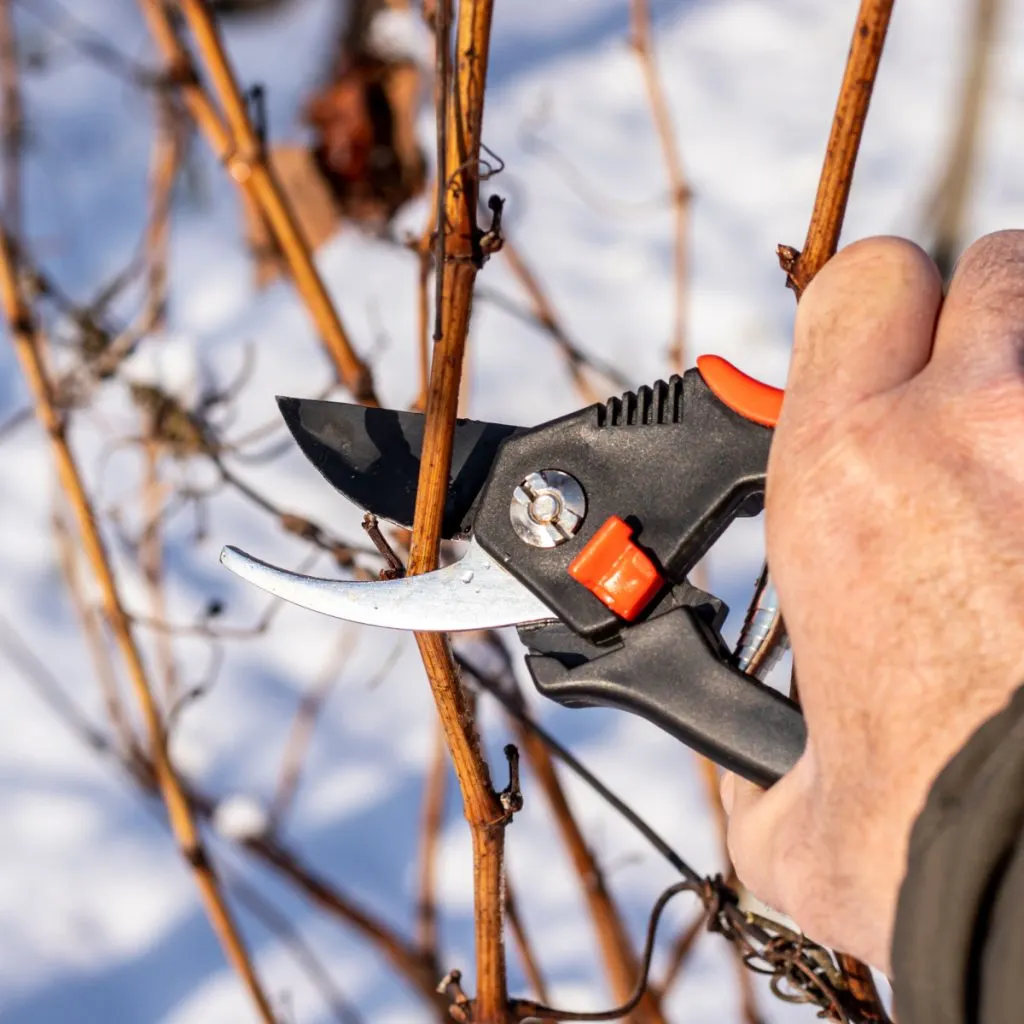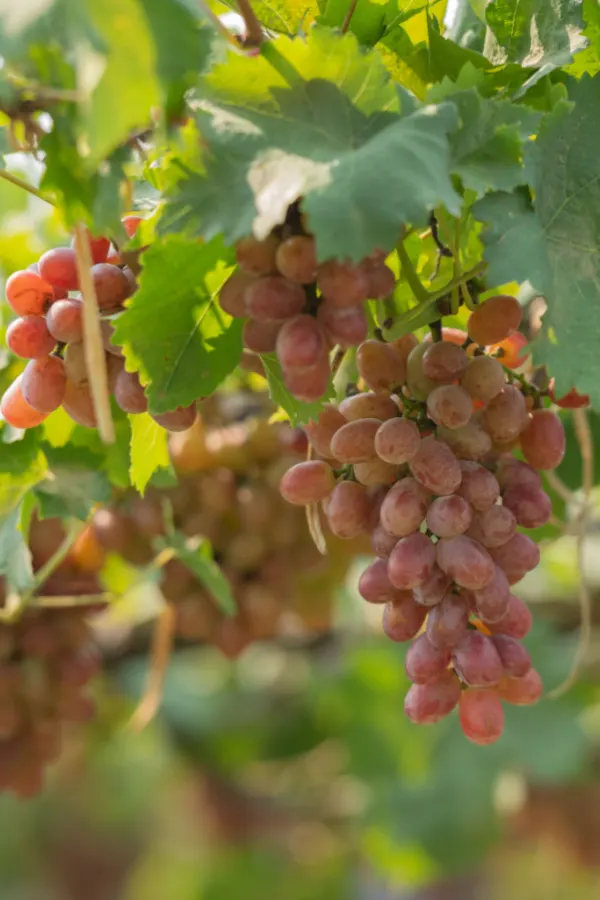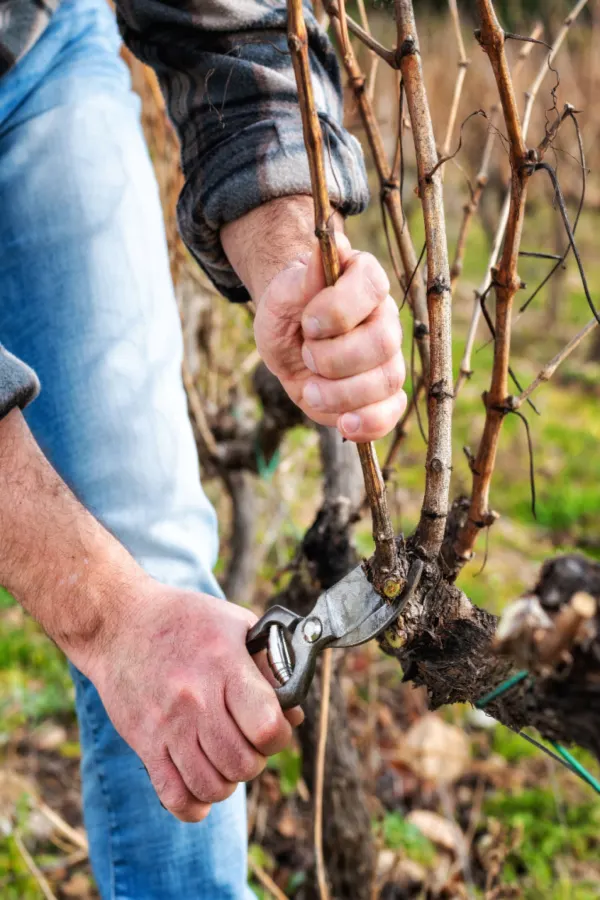Although it might seem a bit cold to be performing gardening chores – winter is actually the perfect time to prune grapevines. In fact, it really is the only time you should be pruning this fruit’s vines!
One thing is for sure, pruning is critical for maintaining healthy and productive grapevines. Especially, as you’ll see below, once your vines really begin to grow after their first year in the ground. While the process of pruning itself isn’t overly complex, timing is everything when it comes to cutting back your vines.
Unlike most perennial plants that are typically pruned in early spring or autumn, grapevines require trimming during the winter. This is because pruning must be done while the plants are fully dormant, Why? Because it is the only way not to harm the vines and jeopardize the next season’s harvest.

Keeping Grapevines Safe
Pruning grapevines during active growth, budding, or fruit production can severely stress and harm the plants. Even in the autumn, when vines might appear dormant, they are still consuming nutrients and energy. And this makes pruning even at this stage potentially damaging.
The ideal time to prune is in the heart of winter – typically from late December through early March. This is when the vines are in full dormancy. And because of that, it’s the perfect opportunity to get the job done without risking harm to the plants.
Interestingly, all of the issues above highlight why it’s just as important to prune other fruit-bearing plants like apple, cherry, and plum trees during the winter. You need to prune all of these while they are dormant to keep the plants safe. See our article: Pruning Apple Trees In Winter – How & Why To Prune Your Trees When It’s Cold!
The Importance Of Pruning – Why You Need To Prune Grapevines In The Winter
So why not just let your grape vines grow as big as they can year after year? As it turns out, pruning your grapevines annually is actually important for several reasons. Not only does it benefit the plant’s overall health, but also its ability to produce fruit.
Without regular pruning, grapevines can quickly grow to an unmanageable mass of shoots and vines. Moreover, older stems, which are known as canes, no longer produce fruit. And if you leave these in place, the non-productive canes drain vital nutrients that the plant could otherwise use to support new growth and fruit development.

Excessive growth can also block sunlight from reaching the plant. And that too can lead to a myriad of issues for grapevines. When vines are overcrowded, the poor airflow and limited light exposure increase the risk of pests and diseases taking hold. They also can delay ripening as sunlight simply can’t reach the fruit.
Now that we know how important pruning is and why to do it in the winter – let’s tackle the process of how to prune like a pro!
How To Prune Grapevines In The Winter
Surprisingly enough, when it comes to pruning, one of the most common mistakes gardeners make is not pruning their grapevines aggressively enough. A gentle trim simply isn’t sufficient to set the stage for a productive growing season. Not just in the number of grapes they will produce, but also their flavor.
Effective pruning involves cutting away the majority of the old wood. All while preserving the vine’s basic overall structure and keeping the wood that will produce grapes in place. This process makes for stronger plants that will produce far better than if they simply were allowed to grow at will.
A grapevine consists of four key parts above ground: the trunk, branches (called cordons), spurs, and canes. Knowing what and where each of these four parts is really the biggest key to successful pruning.
The trunk is the main structure of the vine. It emerges directly from the ground. Proper pruning of this will shape the plant into a “T” or “Y” formation, with branches extending out from the trunk. Spurs then grow along the branches. From the spurs, the canes then develop and grow. Canes are where all of the small buds are located – and these buds are where new grape clusters will eventually form.

The Art & Ease Of Pruning – Why You Need To Prune Grapevines In The Winter
So what parts do you need to prune and what parts do you need to leave? For starters, if you just planted your grapes this year, the good news is that you do not need to prune any part of your grapevines.
If you happen to have a wild growth on a branch, you can certainly trim it back. But in general, it’s best to allow newly planted grape vines an extra year of full growth. If your grapes have been growing for two seasons or more – then it’s time to prune!
Before making the first cut anywhere, make sure your pruners are sharp and clean. Dull pruners can tear vines, damaging them in the process. And always wipe down blades to ensure no disease can be carried between vines. Affiliate Link: GrowIt 8.5″ Professional Titanium Bypass Pruning Shears
What To Cut – Why You Need To Prune Grapevines In The Winter
When pruning, the first place to start is to remove any dead, damaged, or diseased canes. These will only take energy from the vines and put them at risk of pests and more disease.
Next, select 1-4 of the healthiest and thickest canes from the previous year’s growth to keep as the main fruiting canes. When pruning grapevines, remember that grapes grow only on last year’s canes. You can spot these canes because they are lighter brown and smoother than older ones.

If your vines have canes older than a year, you’ll need to remove them. They will be darker in color. You need to remove all of these as they will not produce fruit.
For the lighter canes that will produce fruit (one year old canes), trim each of these selected canes, leaving 8-15 buds on each. Additionally, leave 1-2 shorter canes, known as renewal spurs, with only 2-3 buds to promote future growth.
Once you have everything cut back, the final chore is clean up! Always make sure to pick up and discard all of the trimmings. Leaving them in place can attract disease and pests. Now it’s time to sit back and wait for spring!
Here is to taking the time to prune your grapevines this winter – and preparing your vines to produce better than ever next summer.
This Is My Garden
Follow Our Facebook Page For Great Gardening Tips And Advice! This Is My Garden Facebook Page
This Is My Garden is a garden website created by gardeners, for gardeners. Jim and Mary Competti have been writing gardening, DIY and recipe articles and books and speaking for over 15 years from their 46 acre Ohio farm. They publish three articles every week, 52 weeks a year. Sign up today to follow via email, or follow along!
